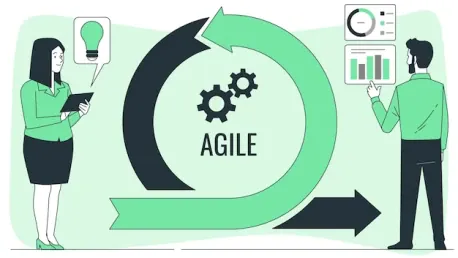In an era marked by rapid technological advancements and the lingering impacts of a global pandemic, the shift to remote and hybrid work has become inevitable. Program Increment (PI) planning, a cornerstone of the Scaled Agile Framework (SAFe), traditionally relies on in-person collaboration. However, organizations must now adapt to ensure seamless PI planning in distributed work environments. The imperative to transition from physical to digital means is not merely a response to the pandemic but also a strategic necessity to remain competitive in today’s fast-evolving business landscape.
The Essence of PI Planning
PI planning is essential for large-scale coordination among agile teams, facilitating the development and delivery of digital products. Historically, these planning sessions relied heavily on face-to-face interactions and physical tools like boards and sticky notes. This method fostered strong collaboration and real-time problem-solving, creating an environment where teams could communicate openly and efficiently. The physical presence of team members allowed for immediate feedback, swift decision-making, and a shared understanding of the tasks at hand.
The onset of COVID-19, however, necessitated an immediate pivot to remote PI planning. This sudden change often hampered the effectiveness of these activities, revealing significant challenges in maintaining the same level of collaboration and coordination. Teams struggled with the lack of physical proximity, which made it harder to engage in spontaneous discussions and quick problem-solving sessions. The transition also highlighted gaps in technology and processes that were not previously apparent when planning was conducted in person. Therefore, rethinking PI planning in a remote or hybrid setting requires a nuanced approach to preserve its essence while enhancing its adaptability and resilience.
Navigating the Remote Workforce
Today’s organizations feature a blend of remote, hybrid, and onsite work arrangements. This evolving landscape raises questions about the feasibility of returning to traditional in-person PI planning. The need to adapt to these changes is more pressing than ever, as organizations must ensure that their agile planning processes can accommodate diverse working conditions without compromising on efficiency or effectiveness. Furthermore, the global talent pool has expanded, making it common for teams to comprise members from different geographic locations and time zones.
To address these challenges, companies must critically evaluate and select digital platforms that support remote PI planning. These platforms are not mere stopgaps but essential tools for sustaining efficiency and collaboration among distributed teams. The selection process should prioritize platforms that offer robust communication features, real-time data sharing, and integration capabilities to create a seamless planning experience. Organizations must also consider the specific needs of their teams, such as accessibility, user-friendliness, and scalability, to ensure the chosen solution aligns with their operational requirements and long-term goals.
Enhancing the Planning Process
Effective PI planning hinges on having accessible and shareable data. Digital platforms can provide a single source of truth, ensuring all team members have access to accurate, up-to-date information. The creation of program boards, integral to PI planning, benefits from the precision and integration offered by these digital tools. These digital program boards enable teams to visualize the planning process more clearly, identify dependencies, and track progress in real-time, fostering a more organized and transparent environment. This centralized approach minimizes the risk of miscommunication and ensures that all stakeholders are aligned on the project’s objectives and status.
Moreover, digital solutions allow for streamlined pre-program planning, enabling teams to input their capacities and adjust time boxes well before the planning event. This preparation ensures a smoother and more organized PI planning process, reducing the likelihood of last-minute changes and disruptions. Teams can use these digital tools to simulate various scenarios, assess potential risks, and develop contingency plans, thereby enhancing their preparedness and confidence. Additionally, automated reminders and notifications keep participants informed and engaged, ensuring that key deadlines and milestones are met.
Collaborative Tools and Features
Collaboration remains a critical element of PI planning, yet traditional methods often led to siloed information. Digital platforms can bridge these gaps by fostering communication through features like comments, @mention tagging, and integration with common messaging apps. These tools facilitate quick, asynchronous discussions, allowing team members to share updates, provide feedback, and ask questions irrespective of their location or time zone. This enhances connectivity and keeps everyone in the loop, promoting a more cohesive and responsive team dynamic.
Additionally, digital tools can enhance elements like confidence voting, surveys, and retrospectives. These features not only boost engagement but also provide meaningful insights that can drive continuous improvement. For instance, confidence voting allows team members to express their confidence levels in the planned tasks, helping to identify potential issues early. Surveys and retrospectives offer structured opportunities for teams to reflect on their performance, share lessons learned, and propose improvements for future iterations. By leveraging these digital capabilities, teams can ensure that their collaborative efforts are more inclusive, transparent, and data-driven.
Transitioning to Execution
One of the significant advantages of digital platforms is the ability to transition swiftly from planning to execution. These tools offer real-time updates, ensuring teams can apply their plans immediately without the delays and errors associated with manual data entry. This seamless transition is crucial for maintaining the momentum generated during the PI planning event, allowing teams to start work on high-priority items right away. Real-time updates also enable teams to monitor progress continuously, adjust plans as necessary, and address any issues promptly.
This agility in execution is vital for maintaining the momentum initiated during the PI planning event. Teams can quickly adapt and respond to changes, reflecting the true essence of agile principles. Digital platforms provide dashboards and reporting features that give stakeholders visibility into the project’s status, performance metrics, and any emerging risks. This transparency ensures that decision-makers have the information they need to make informed choices and keep the project on track. Furthermore, the automation of routine tasks and the centralization of information help to reduce the administrative burden on team members, allowing them to focus more on value-adding activities.
Financial Visibility in PI Planning
Historically, PI planning primarily focused on managing labor costs. Modern organizations, however, recognize that agile delivery impacts more than just workforce expenses. It also influences product total cost of ownership (TCO), business spending, and revenue. Understanding these broader financial implications is essential for making strategic decisions that align with the organization’s goals and objectives. Therefore, financial visibility must be integrated into the PI planning process to ensure that all relevant costs and benefits are accounted for.
Incorporating these financial aspects into PI planning is critical. Despite this need, many existing platforms fall short in providing comprehensive financial visibility. Selecting tools that offer detailed financial integration can lead to more informed and strategic planning. This includes features that track budget allocation, monitor expenditure, and project future financial impacts. Enhanced financial visibility enables teams to align their efforts with the organization’s financial strategy, ensuring that resources are used efficiently and that projects deliver maximum value. It also helps to identify potential financial risks early, allowing for proactive mitigation and better overall financial management.
Improving Overall Planning Experience
For organizations with distributed workforces, digitizing PI planning is paramount to sustaining collaborative efficiency. The right platform eliminates information silos, reduces knowledge gaps, and improves synchronization among teams. This holistic approach ensures that every team member remains aligned with the overall program goals. Enhanced communication features, real-time data access, and collaborative tools create a more integrated and responsive planning environment, fostering a culture of continuous improvement and innovation.
Digitization of the PI planning process isn’t a temporary fix but a transformative step toward more efficient agile collaboration. The benefits of real-time data sharing, enhanced collaboration tools, and integrated financial analysis make a compelling case for adopting digital platforms. As organizations continue to navigate the complexities of remote and hybrid work, investing in the right digital solutions will be key to maintaining a competitive edge and achieving sustainable success. By embracing these technologies and refining their agile practices, organizations can ensure that their planning processes are more resilient, adaptive, and aligned with the demands of the modern business landscape.
Maximizing the Benefits of Digital PI Planning
In an age where technological advancements are happening at lightning speed and the effects of a global pandemic still linger, the move to remote and hybrid work setups has become a necessity. Traditionally, Program Increment (PI) planning—an essential element of the Scaled Agile Framework (SAFe)—has depended heavily on face-to-face collaboration. However, in the current climate, businesses need to adapt to ensure PI planning can be executed smoothly even in a distributed work environment. The shift from physical to digital methodologies is more than a response to the pandemic. It is a strategic move critical for remaining competitive in today’s swiftly changing business world. Embracing these digital solutions not only ensures business continuity but also fosters innovation and resilience. Companies that successfully transition to digital PI planning will be better positioned to adapt to future disruptions and leverage the advantages of remote and hybrid work models.









